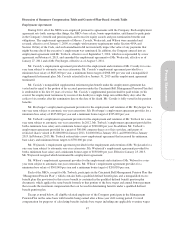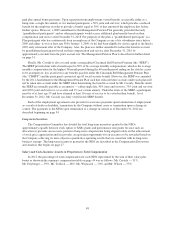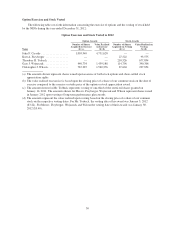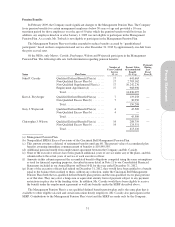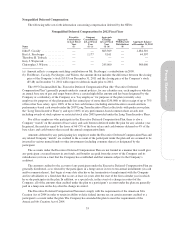Cincinnati Bell 2012 Annual Report Download - page 67
Download and view the complete annual report
Please find page 67 of the 2012 Cincinnati Bell annual report below. You can navigate through the pages in the report by either clicking on the pages listed below, or by using the keyword search tool below to find specific information within the annual report.
(b) Mr. Cassidy’s non-equity incentive compensation payment is contingent on the Company’s attainment of target performance metrics for
the 2013 and 2014 performance years and is indexed to the Company’s stock price at the end of each performance year. The table
includes the target payout, but the actual payout based on performance metric attainment and the Company’s stock price could range
from zero to $5 million.
(c) Basic benefits consist of medical, dental, vision and group term life insurance similar to such benefits provided by the Company to other
employees.
(d) The tax gross-up amounts are meant to defray related tax liabilities related to a change in control. The discount rate used for retiree
benefit change in control values was 3.30%, consistent with the rate determined for the Company’s financial statements under
Accounting Standards Codification Topic 960. No tax gross-up was required for Messrs. Cassidy and Wilson at December 31, 2012, as
the aggregate present value of all change in control compensation payments is less than three times the individual’s base amount;
therefore, no portion of the payments is a parachute payment. On April 27, 2010, the Compensation Committee adopted a policy that the
Company would no longer enter into new or materially alter employment agreements with named executive officers providing for excise
tax gross-ups upon a change of control. As a result, the employment agreements of Messrs. Freyberger, Torbeck, and Wojtaszek do not
contain any excise tax gross-up provisions.
(e) Performance shares include shares that are based on the attainment of target performance metrics in the 2013 performance year. These
awards have been included in the table at target; however, the actual payouts based on attainment of the metrics could range from zero to
200% of the target amount.
(f) If Mr. Torbeck’s employment is terminated due to disability or an involuntary not for cause termination, then he is entitled to a lump sum
cash payment equal to two times his salary in calendar year 2013.
(g) Mr. Wojtaszek resigned effective January 23, 2013; therefore, he is no longer eligible for any payments upon termination or change in control.
If any of the executives elects to voluntarily terminate employment with the Company, or if they are
terminated by the Company for cause, they are entitled to no payments from the Company other than those
benefits which they have a non-forfeitable vested right to receive (the “vested amounts”), which include any
shares of stock they own outright, vested options which may be exercisable for a period of 90 days following
termination, deferred compensation amounts and vested amounts under the Company’s long-term incentive plan,
pension and savings plans. Mr. Wojtaszek voluntarily resigned from the Company on January 23, 2013 and
Mr. Cassidy retired from the Company on January 31, 2013 and although their employment agreements have
otherwise been terminated, each of Messrs. Wojtaszek and Cassidy remains bound by the non-disclosure, non-
compete and non-solicitation provisions of their employment agreements.
In addition to any applicable “vested amounts,” an executive will be entitled to receive certain additional
benefits if one of the four termination scenarios detailed in the above table and discussed below occurs.
Regardless of the termination scenario, each executive will continue to be bound by the non-disclosure, non-
compete and non-solicitation provisions of their employment agreements. Because, as noted above, Messrs.
Cassidy and Wojtaszek each terminated their employment with the Company in January 2013, Messrs. Cassidy
and Wojtaszek will not be discussed and the discussions below regarding the impact on executives in the event of
the occurrence of one of the four termination scenarios will focus on those executives that remain employed by
the Company (i.e., Messrs. Freyberger, Torbeck and Wilson).
If an executive is terminated by the Company without cause (an involuntary not for cause termination), the
executive will be entitled to the following:
•A payment equal to two times their base salary in the case of Messrs. Freyberger and Torbeck, and 1.65
times his base salary in the case of Mr. Wilson.
•A payment equal to the present value of an additional one year of participation in the Company’s
Management Pension Plan, if applicable, as though the executive had remained employed at the same base
rate of pay and target bonus;
•Continued medical, dental, vision and life insurance benefits during the one-year period following the
executive’s termination of employment on the same basis as any active salaried employee provided any
required monthly contributions are made;
•Continued treatment as an active employee during the one-year period following termination with respect
to any outstanding long-term incentive cycles the executive may be participating in and any unvested
stock options will continue to vest under the normal vesting schedule as though the executive was still an
active employee; and
•The ability to exercise any vested options for an additional 90 days after the end of the one-year period.
55
Proxy Statement




